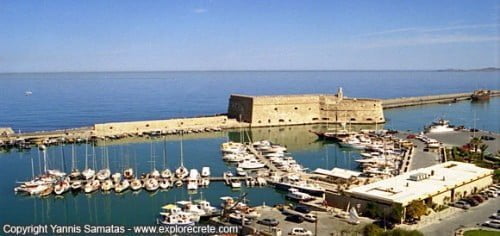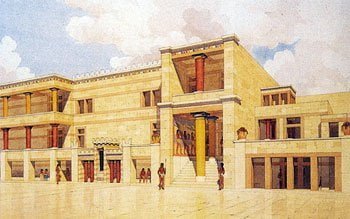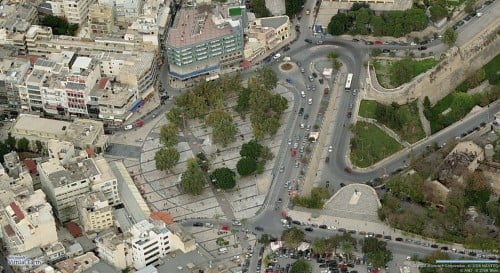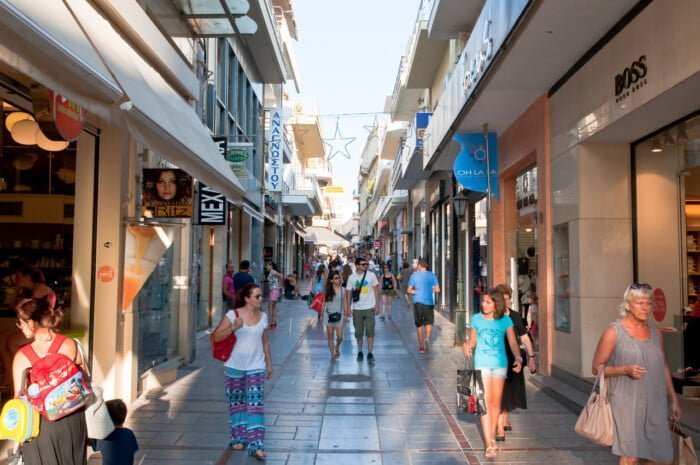Koules in Heraklion, the Venetian fortress Koules
The Venetian Koules in Heraklion
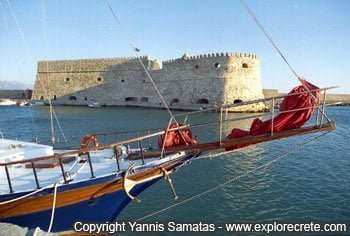 The Venetian fortress of Koules dominates the entrance to the Venetian harbour of Heraklion. The Venetians called it the “Sea Fortress” (Castello a Mare or Rocca a Mare), but today it is known by its Turkish name, Koules, a corruption of Su Kulesi (Water Tower). It is one of the most familiar and beloved monuments of the city, and the symbol of Heraklion.
The Venetian fortress of Koules dominates the entrance to the Venetian harbour of Heraklion. The Venetians called it the “Sea Fortress” (Castello a Mare or Rocca a Mare), but today it is known by its Turkish name, Koules, a corruption of Su Kulesi (Water Tower). It is one of the most familiar and beloved monuments of the city, and the symbol of Heraklion.
Today the fortress of Koules gazes proudly out across the Sea of Crete, reminding us of the glory of Venetian Chandax. It is haunted by legends that Cretan rebels were horribly tortured in its damp, dark rooms.
Koules, history

We do not know the precise origins of the history of Koules, but a harbour in such a strategic position in the Mediterranean could not remain undefended. The first fortress was probably built on the site of Koules during the Arab period (9th-10th c.), while there is a reference to a tower called the Castellum Comunis at the harbour entrance in the Second Byzantine period (10th-13th c.) Several sketches by travellers who mapped Heraklion show a tower at the harbour entrance, the earliest being that by Buondelmonti in 1429.
The tower is depicted as a tall structure with sheer walls, either circular or oblong in layout. These depictions are not necessarily to be trusted, as the structure rather resembles a Western European fortification.
In the mid-14th century, gunpowder (a mixture of nitre, sulphur and carbon) made its appearance in Europe. It came to play such a major part in warfare, radically changing military science, that it replaced existing machines of war and neutralised the defensive capabilities of earlier fortifications.
Thus the mid-15th century found Heraklion inadequately fortified and the harbour tower, the Byzantine Castellum Comunis, weak and useless for purposes of defence. In 1462 the Venetian Senate approved an ambitious programme of fortification of the city, which was to defend both Heraklion and the burgs (suburbs) outside it, according to the principles of the new bastion front system. As part of this project, the harbour tower was demolished in 1523 and replaced by the Koules fortress still standing today.
The natural rocky outcrop at this point of the harbour was banked up extensively to form the platform on which the fortress was to be built, covering an area of 3,600 m2. The work was carried out in a very interesting way: old ships were filled with stone from the island of Dia and sunk off the north side of the mole, forming a breakwater and increasing the space available.
The Construction of Koules
Work on Koules continued until 1540. The outer walls are almost 9 metres thick, while the inner walls are up to 3 metres thick at some points. The sea damaged the foundations from early on, and repairs were carried out at intervals. The fortress also had many weak points, due to the fact that it was built in a transitional period when fortification architecture was still at an experimental stage.
Structurally speaking, Koules is formed of two sections:
- the south-western, rectangular section, slightly higher
- the north-eastern, semi-elliptical section, slightly lower.
There were three entrances to the fortress, on the west, north and southwest sides; the main gate was on the west. Various plaques, inscriptions and coats of arms carved in relief were set into the outer walls. The best are the three marble reliefs depicting the winged lion of St Mark, the symbol of the Most Serene Republic of Venice, one over each entrance. Two of them are still preserved today, clearly weathered by constant exposure to the sea air.
The fortress is a two-storey building with 26 rooms. There were originally five casemates (special areas for cannon) on the ground floor. It soon became apparent, however, that the use of guns indoors was problematic, due to the limited field of vision through the narrow embrasures, and the choking smoke produced on firing. Thus the cannon were moved to open platforms on the upper storey and the casemates were abandoned.

The ground floor also housed a prison and various storage areas for food and munitions.
On the north side of the upper storey, which formed a spacious square, was the lighthouse tower. There were also quarters for the soldiers, the officers and the governor.
The fortress also contained its own mill, oven and chapel, ensuring the autonomy of its garrison.
The fortress of Koules did not play a particularly important part during the Turkish siege of Chandax (1646-1669), as the Turkish batteries, strategically placed, were able to neutralise its firepower fairly early on and the Turks gained control of the harbour entrance.
No major modifications were carried out to Koules during the period of Turkish rule, apart from the addition of stone battlements with fire steps for their musketeers, and gun embrasures. The Turks built a smaller fortress, known as Little Koules, opposite Koules on the landward side. Unfortunately this monument was demolished along with part of the Venetian shipyards in 1936, during the modernisation of the city.
Today Koules is occasionally used for art exhibitions held indoors on the ground floor and plays or concerts on the top floor, weather permitting.You can visit Koules from 08:30 to 15:00 in the winter and 19:00 in the summer, every day except Mondays.
© explorecrete.com All Rights Reserved. Reproduction or copying without permission is prohibited.

